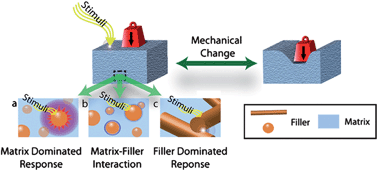Stimuli-responsive, mechanically-adaptive polymer nanocomposites
Abstract
Stimuli-responsive nanocomposites composed of functional

* Corresponding authors
a
Department of Macromolecular Science and Engineering, Case Western Reserve University, Cleveland, USA
E-mail:
sjr4@case.edu
Tel: +(216) 368-4242
b
Adolphe Merkle Institute and Fribourg Center for Nanomaterials, University of Fribourg, Switzerland
E-mail:
christoph.weder@unifr.ch
Fax: +41(0)26 300 96 24
Tel: +41 (0)26 300 94 65
Stimuli-responsive nanocomposites composed of functional

 Please wait while we load your content...
Something went wrong. Try again?
Please wait while we load your content...
Something went wrong. Try again?
L. Hsu, C. Weder and S. J. Rowan, J. Mater. Chem., 2011, 21, 2812 DOI: 10.1039/C0JM02383C
To request permission to reproduce material from this article, please go to the Copyright Clearance Center request page.
If you are an author contributing to an RSC publication, you do not need to request permission provided correct acknowledgement is given.
If you are the author of this article, you do not need to request permission to reproduce figures and diagrams provided correct acknowledgement is given. If you want to reproduce the whole article in a third-party publication (excluding your thesis/dissertation for which permission is not required) please go to the Copyright Clearance Center request page.
Read more about how to correctly acknowledge RSC content.
 Fetching data from CrossRef.
Fetching data from CrossRef.
This may take some time to load.
Loading related content
